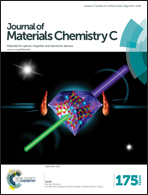Simultaneous enhancement of electrical conductivity and thermopower in Bi2S3 under hydrostatic pressure†
Abstract
The inverse coupled dependence of electrical conductivity and thermopower on carrier concentration presents a big challenge in achieving a high figure of merit. However, the simultaneous enhancement of electrical conductivity and thermopower can be realized in practice by carefully engineering the electronic band structure. Here by taking the example of Bi2S3, we report a simultaneous increase in both electrical conductivity and thermopower under hydrostatic pressure. Application of hydrostatic pressure enables tuning of electronic structure in such a way that the conductivity effective mass decreases and the density of states effective mass increases. This dependence of effective masses leads to simultaneous enhancement in electrical conductivity and thermopower under n-type doping leading to a huge improvement in the power factor. Also lattice thermal conductivity exhibits very weak pressure dependence in the low pressure range. The large power factor together with low lattice thermal conductivity results in a high ZT value of 1.1 under n-type doping, which is nearly two times higher than the previously reported value. Hence, this pressure-tuned behaviour can enable the development of efficient thermoelectric devices in the moderate to high temperature range. We further demonstrate that similar enhancement can be observed by generating chemical pressure by doping Bi2S3 with smaller iso-electronic elements such as Sb at Bi sites, which can be achieved experimentally.


 Please wait while we load your content...
Please wait while we load your content...